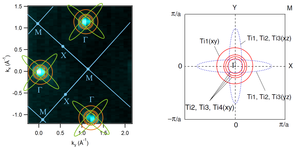P4
Electronic structure and many-body effects in interfaces of oxide heterostructures

M. Sing and R. Claessen
Transcending the capabilities of their conventional semiconductor counterparts, oxide interfaces provide the unique opportunity to control, enhance, and create functionalities such as superconductivity, magnetism, metal-insulator transitions, or topological phases. Striking examples are the correlated interface electron systems that form in the oxide heterostructures LaAlO3/SrTiO3 (LAO/STO) and LaVO3/SrTiO3 (LVO/STO) beyond a critical film thickness.
This project is devoted to the fabrication of such hybrid systems by pulsed laser deposition and the study of their chemical and electronic interface structure by high-energy spectroscopies as well as scanning probe methods. Important questions to be addressed comprise the mapping of ferromagnetic and non-magnetic metallic patches at the LAO/STO interface using the contrast from x-ray magnetic circular dichroism in a scanning x-ray microscope and the in situ investigation of gating effects. Resonant techniques and cross-sectional scanning tunneling spectroscopy will be employed to directly probe the interface states, in particular the band-filling controlled Mott transition in LVO/STO.
Another focus will be on the possibility to tune the dimensionality and hence the correlations of the two-dimensional electron system using vicinal substrates. Varying the LAO thickness and the STO miscut angle, a dimensional crossover has been predicted resulting in one-dimensional chains. We will systematically explore the relevant parameter space employing scanning tunneling microscopy and spectroscopy as well as angle-resolved photoelectron spectroscopy. This topic will be complemented by the investigation of reduced titanate nanowires which can be stabilized on bare STO surfaces.
A last aspect concerns the creation of novel phases by design as has been highlighted lately for perovskite or perovskite-type high-Z metal oxide bilayers with (111)-orientation. In the presence of a large spin-orbit coupling topological insulators may result if the band topology is adjusted properly by applying an electric field or by sandwiching the bilayer between different substrates.

